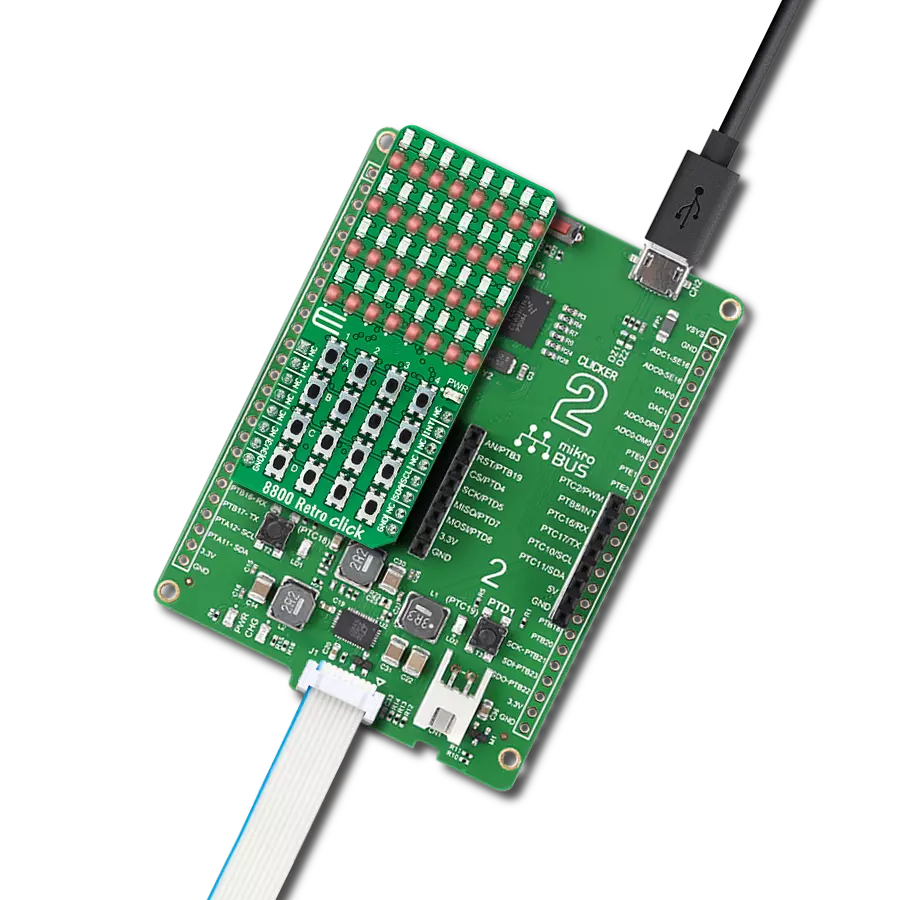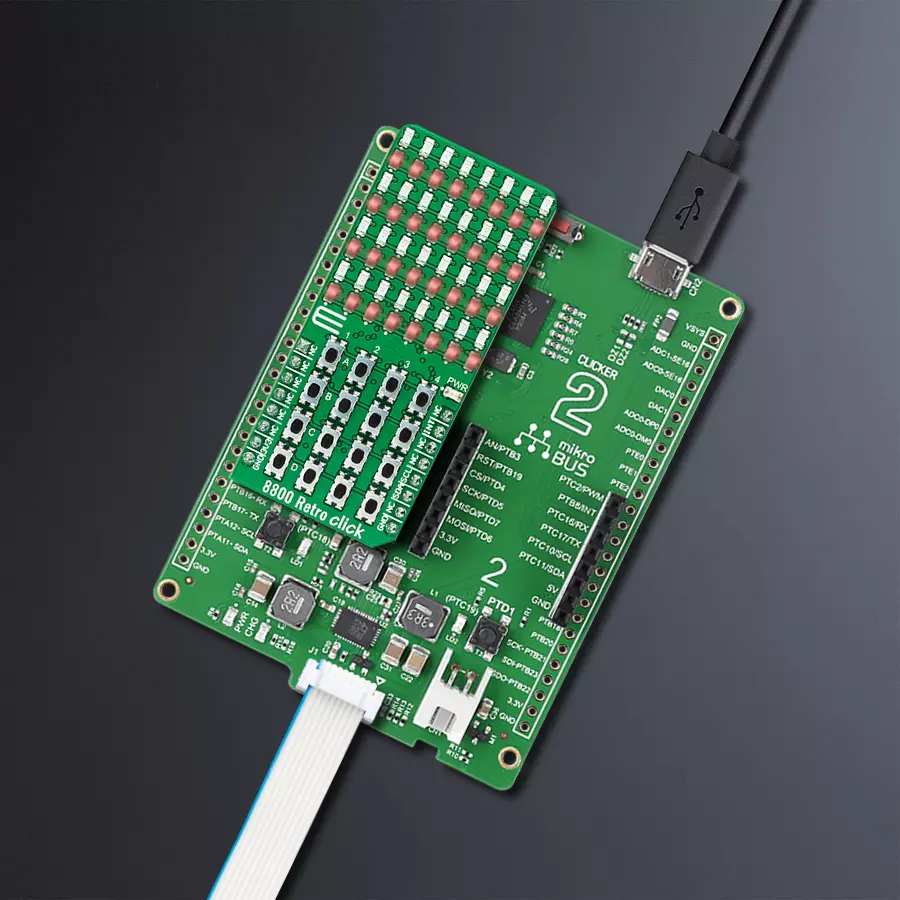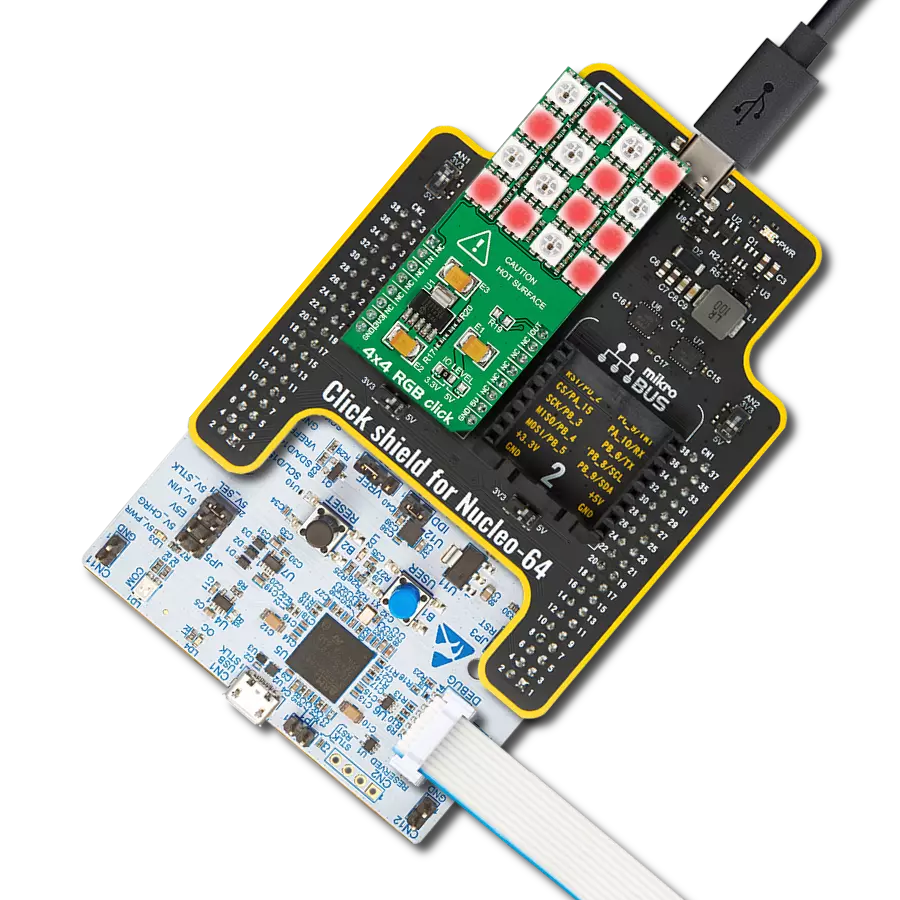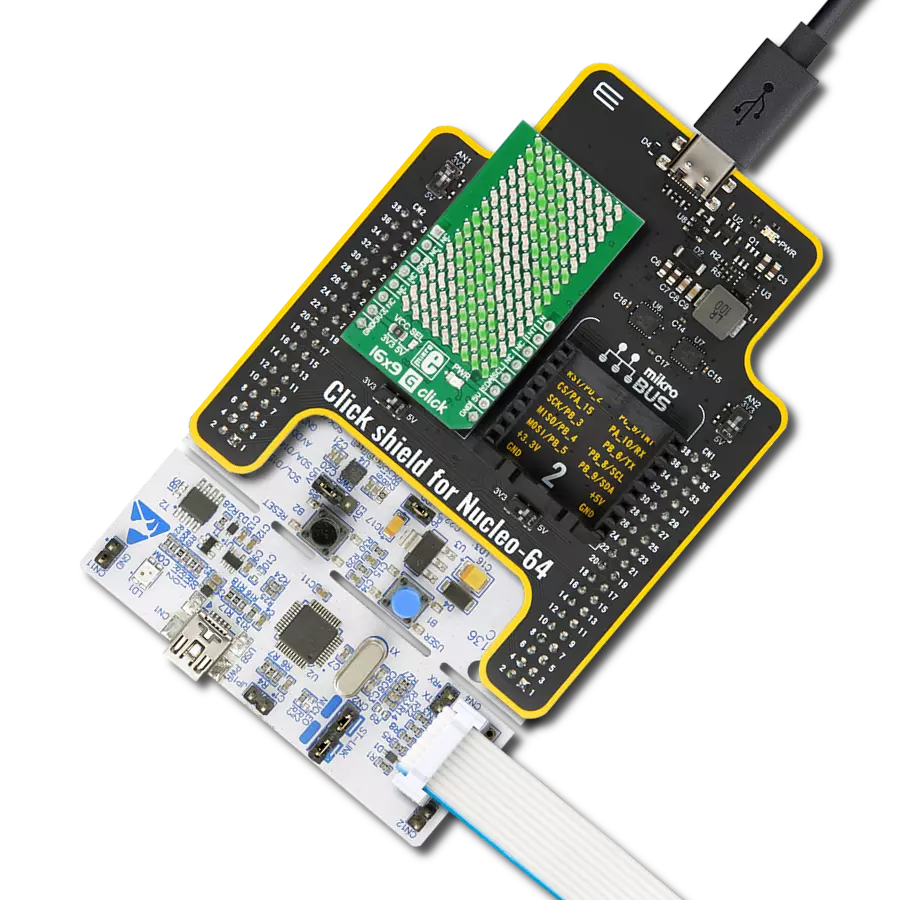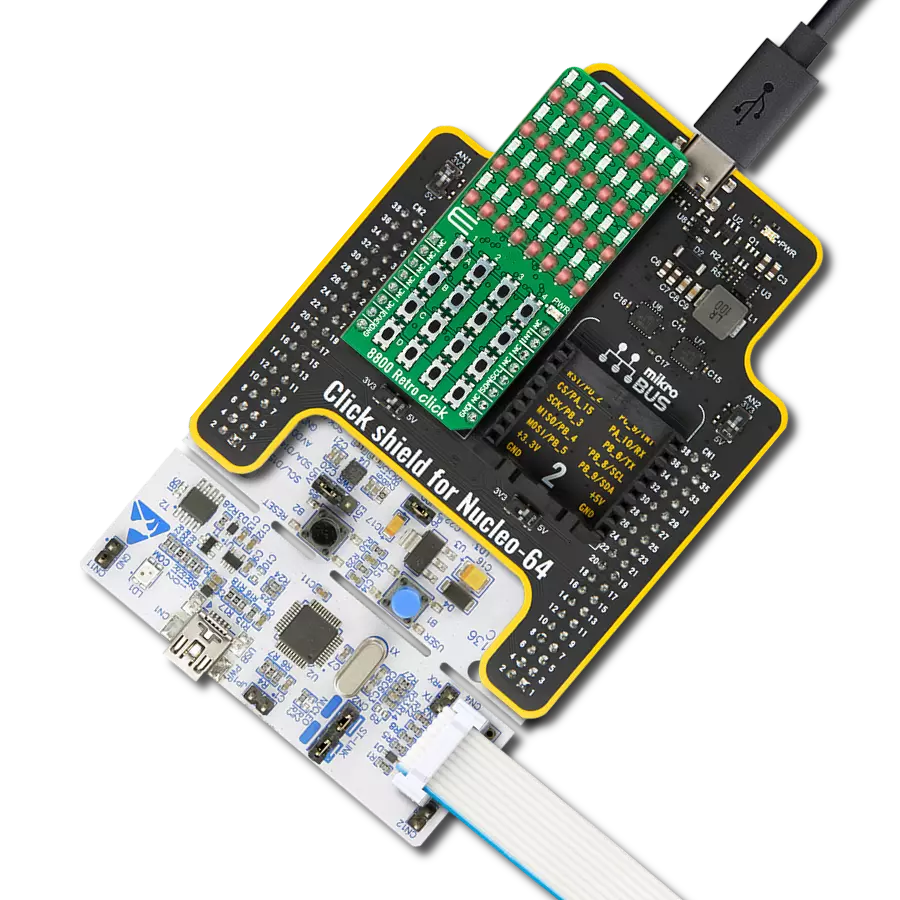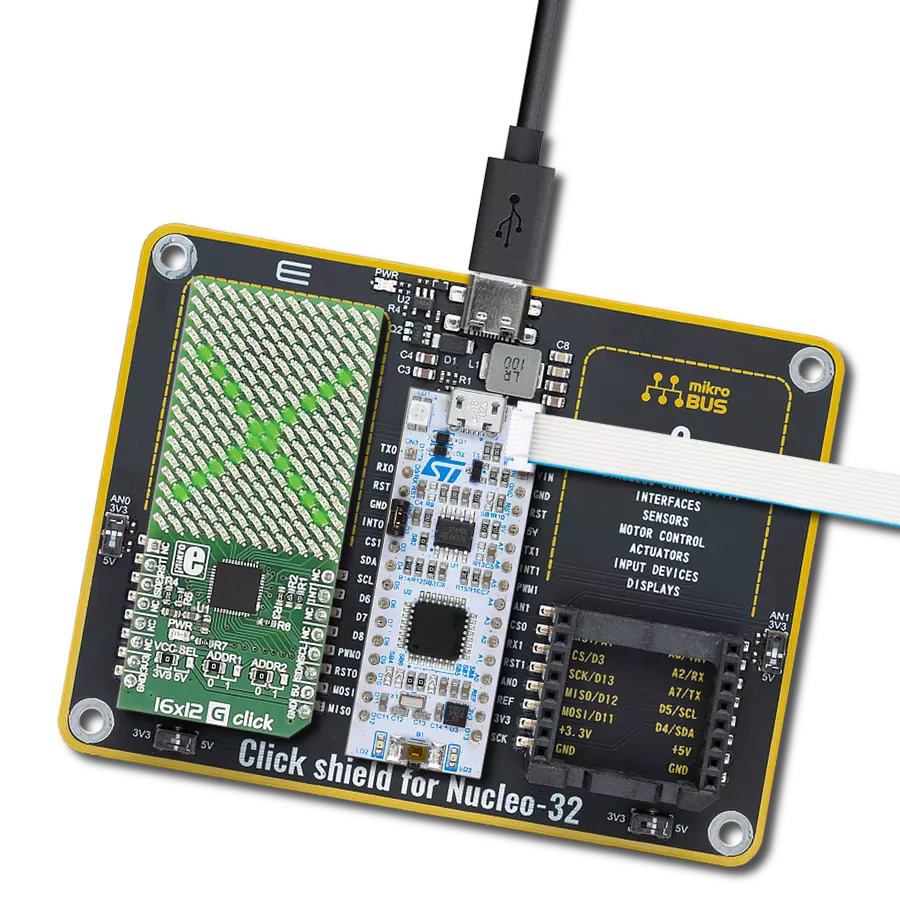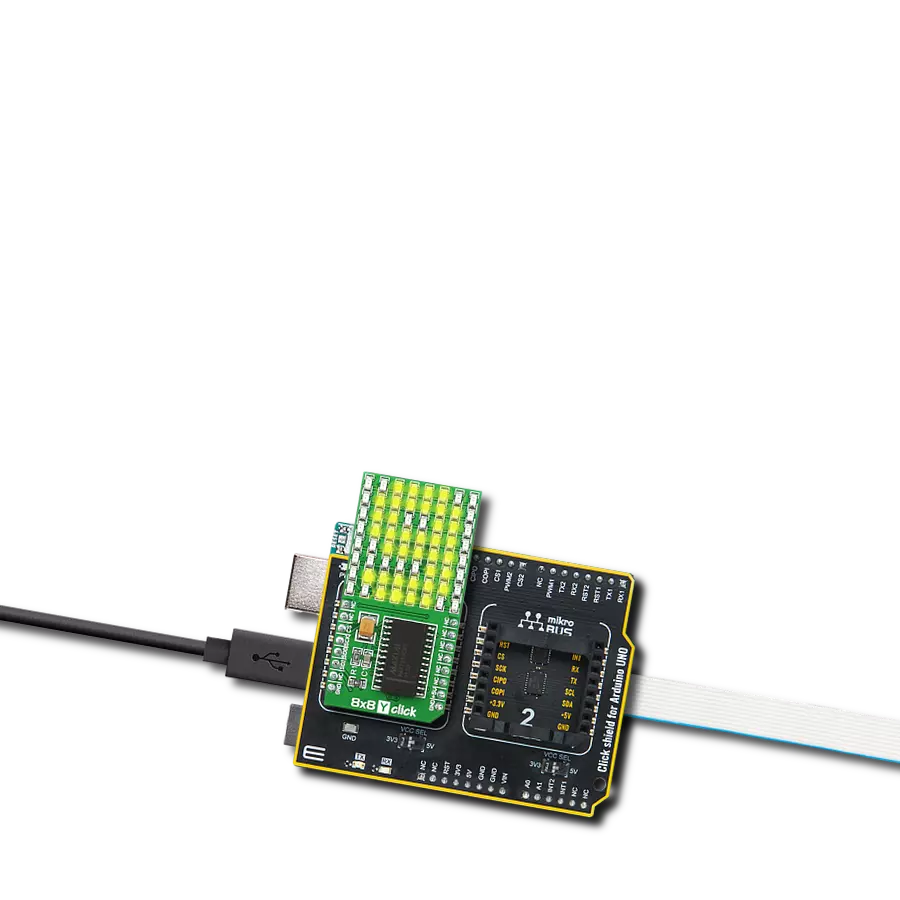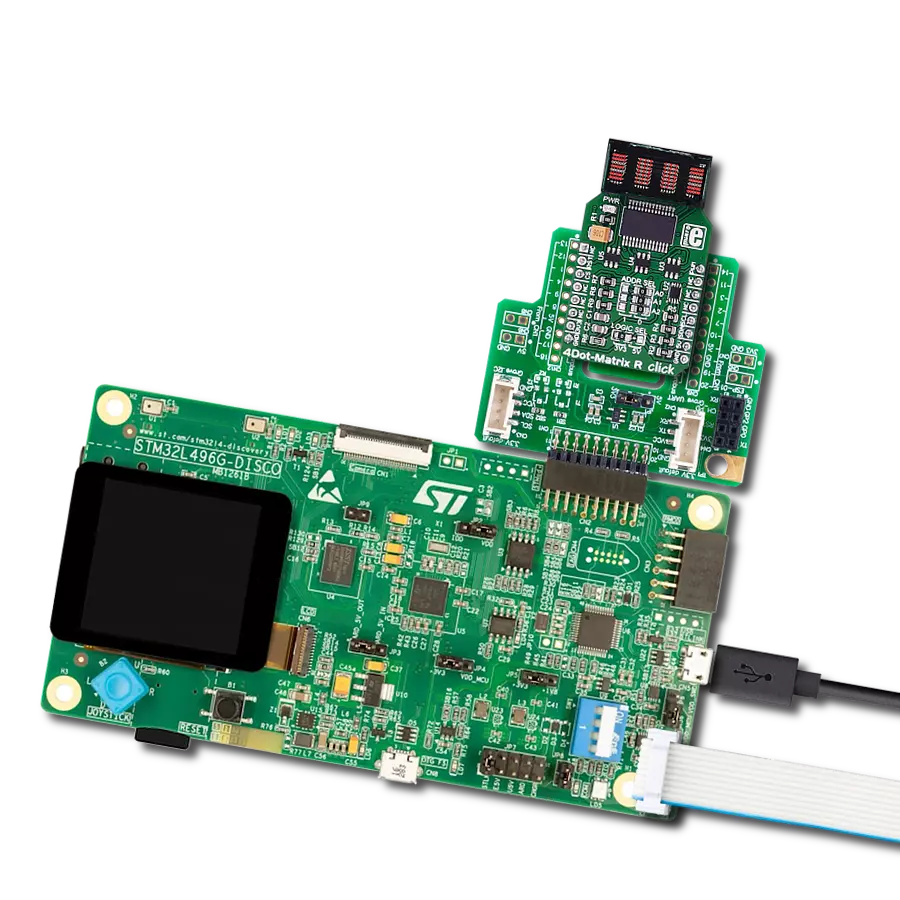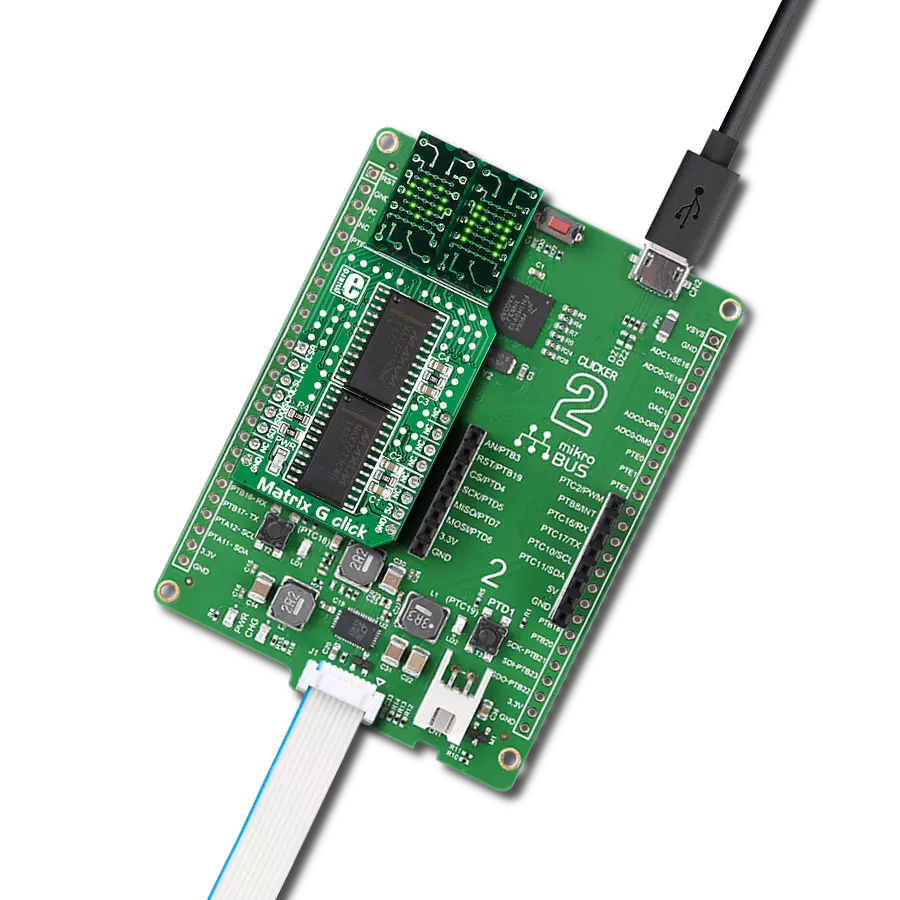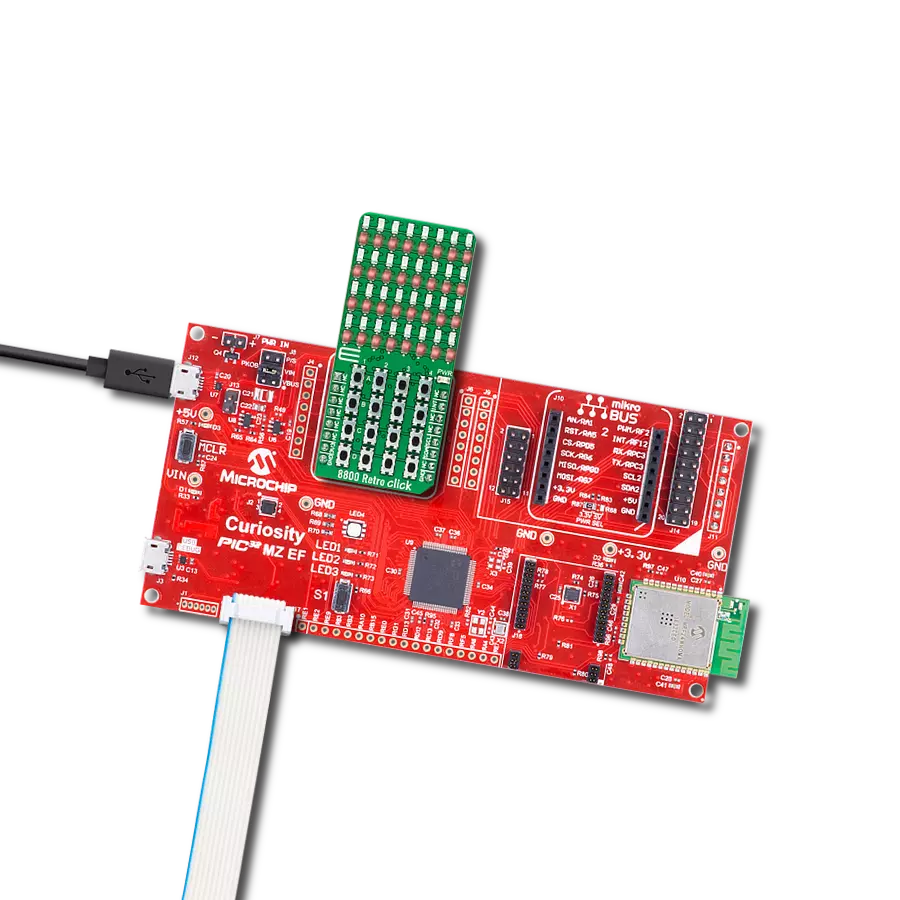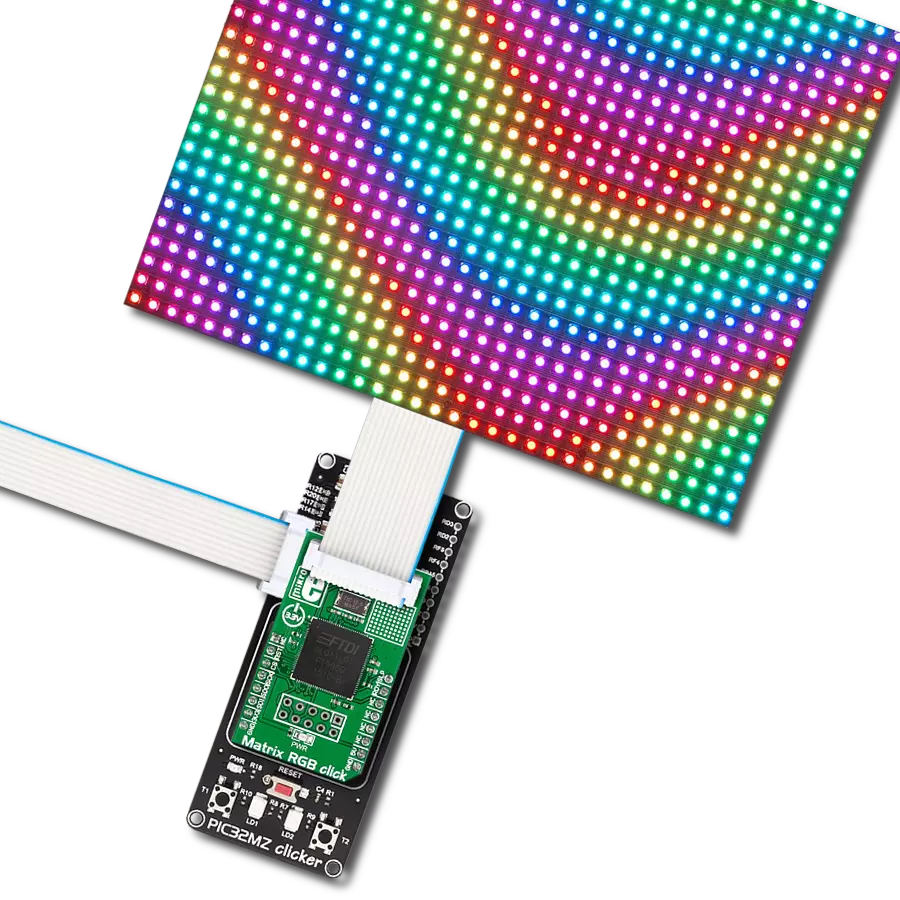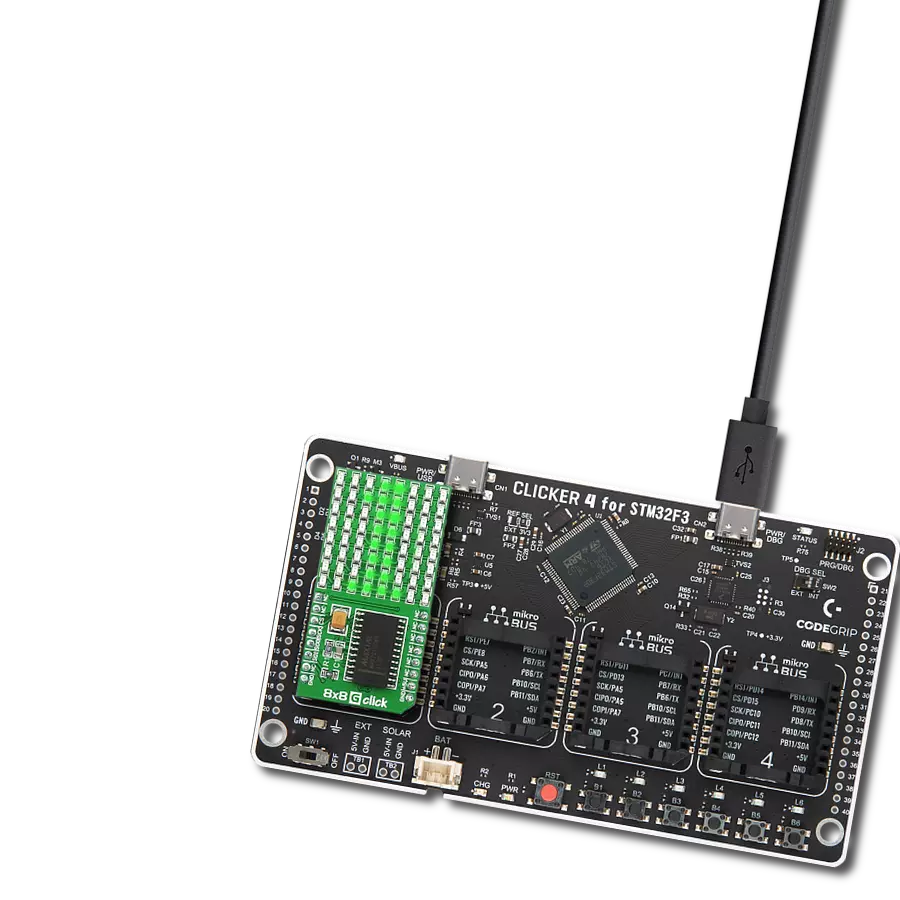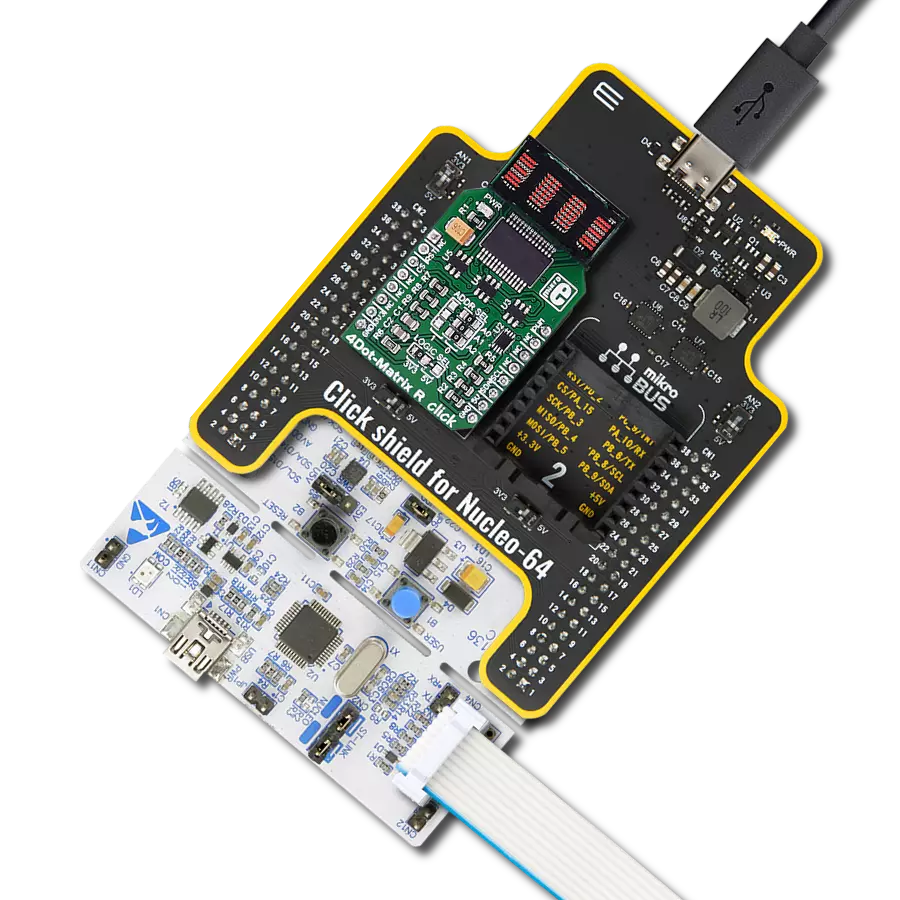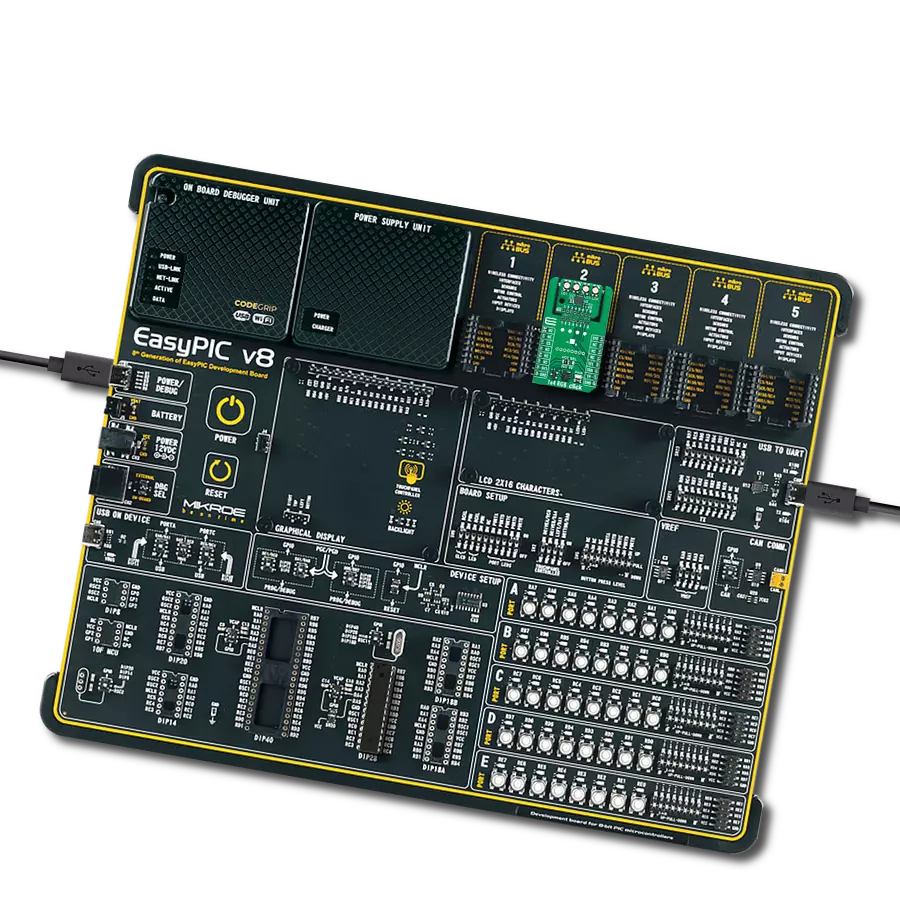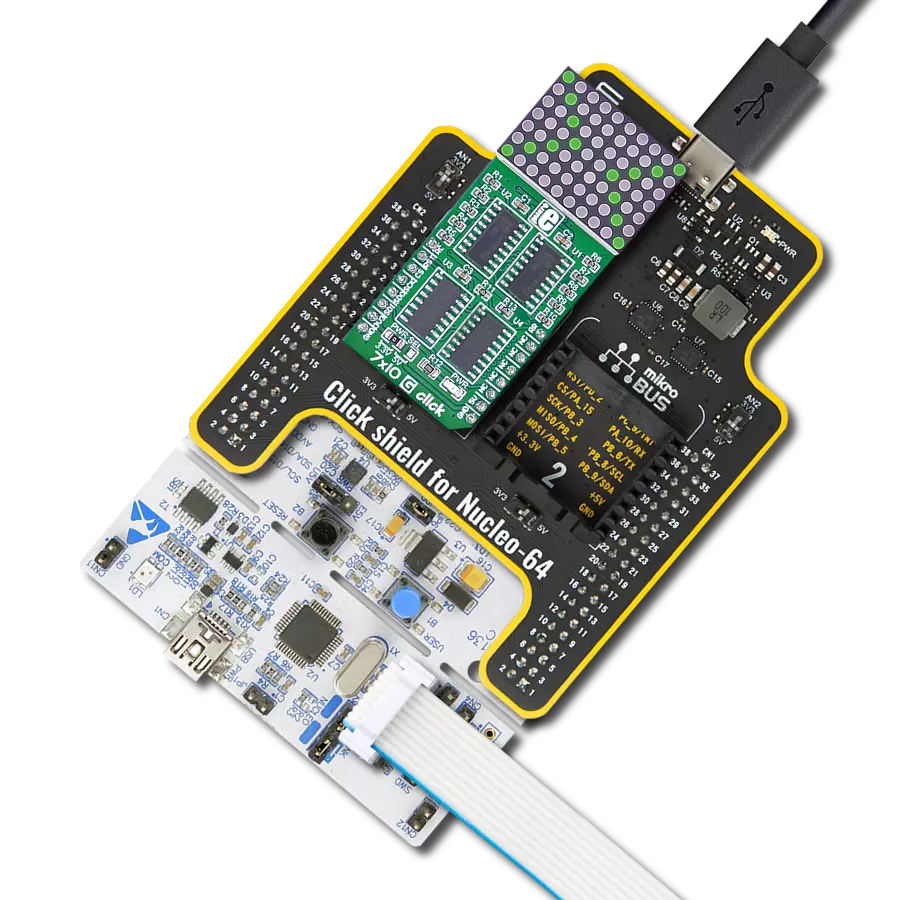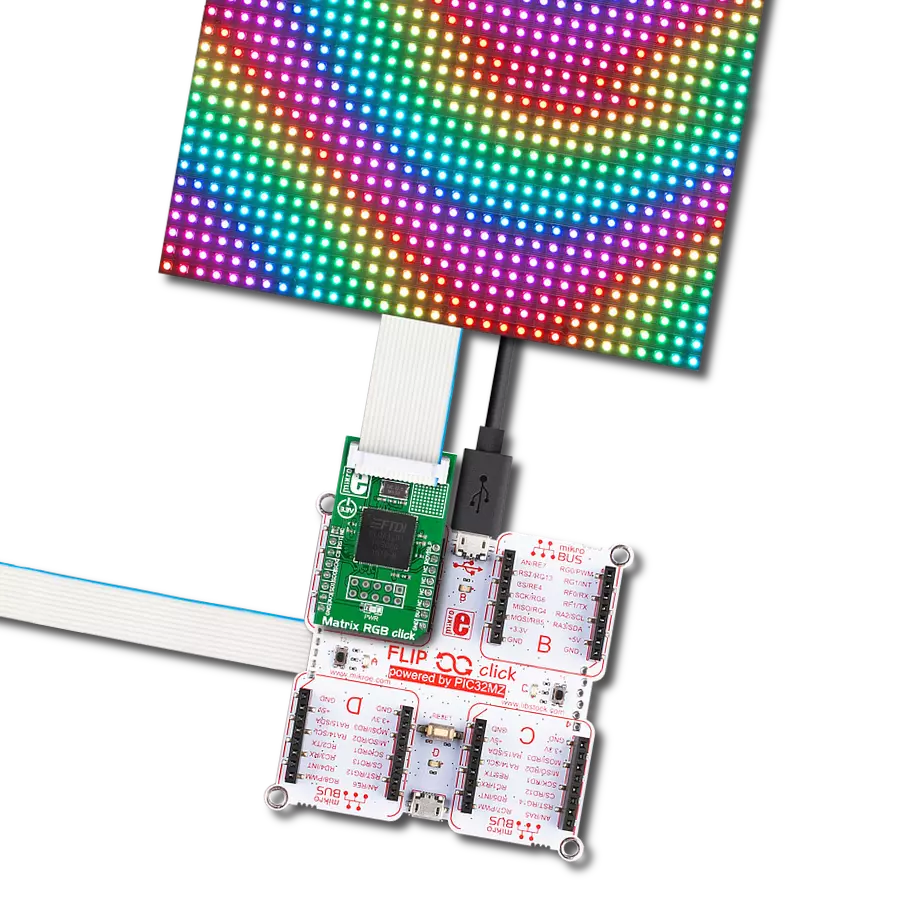发现早期计算机的简单和魅力,与8800 Retro Click一起,这是对传奇的Altair 8800的创新致敬。
A
A
硬件概览
它是如何工作的?
8800 Retro Click基于AMS-AG的紧凑型点阵8x8 LED驱动器AS1115。它包括每个段的4位PWM和仅一个用于LED电流调节(LED亮度)的电阻。AS1115包含一个集成的BCD码-B/HEX解码器,多路复用扫描电路,分段和显示驱动器以及64位存储器。内部存储器存储了移位寄存器的设置,消除了持续设备重新编程的需求。该板适用于七段数码管或点阵用户界面显示以及其他家用电器或个人电子应用。LED列具有共阴极,
连接到数码驱动线,其中每个64个LED可以单独寻址。在初始上电时,AS1115寄存器被重置为默认值,显示被清空,并且设备进入关闭模式。此时,所有寄存器应该被编程为正常操作。AS1115具有通常为200nA的低关闭电流和通常为350μA的操作电流。8800 Retro Click使用标准I2C 2-Wire接口与MCU进行通信,在Fast Mode Plus中的时钟频率可高达1MHz。此外,AS1115可以读取16个按钮,并提供详细的短路/断路
LED错误诊断。因此,为了获得按钮的有效回读,建议在触发mikroBUS™插座上的INT引脚上的IRQ中断引脚后立即读取键扫描寄存器。除了数字-数字编程之外,此Click board™还可以通过软件进行复位。此Click board™只能使用3.3V逻辑电压电平运行。在使用具有不同逻辑电平的MCU之前,板子必须执行适当的逻辑电压电平转换。此外,它配备了一个包含函数和示例代码的库,可用作进一步开发的参考。
功能概述
开发板
Clicker 2 for Kinetis 是一款紧凑型入门开发板,它将 Click 板™的灵活性带给您喜爱的微控制器,使其成为实现您想法的完美入门套件。它配备了一款板载 32 位 ARM Cortex-M4F 微控制器,NXP 半导体公司的 MK64FN1M0VDC12,两个 mikroBUS™ 插槽用于 Click 板™连接,一个 USB 连接器,LED 指示灯,按钮,一个 JTAG 程序员连接器以及两个 26 针头用于与外部电子设备的接口。其紧凑的设计和清晰、易识别的丝网标记让您能够迅速构建具有独特功能和特性
的小工具。Clicker 2 for Kinetis 开发套件的每个部分 都包含了使同一板块运行最高效的必要组件。除了可以选择 Clicker 2 for Kinetis 的编程方式,使用 USB HID mikroBootloader 或外部 mikroProg 连接器进行 Kinetis 编程外,Clicker 2 板还包括一个干净且调节过的开发套件电源供应模块。它提供了两种供电方式;通过 USB Micro-B 电缆,其中板载电压调节器为板上每个组件提供适当的电压水平,或使用锂聚合物 电池通过板载电池连接器供电。所有 mikroBUS™ 本
身支持的通信方法都在这块板上,包括已经建立良好的 mikroBUS™ 插槽、重置按钮和几个用户可配置的按钮及 LED 指示灯。Clicker 2 for Kinetis 是 Mikroe 生态系统的一个组成部分,允许您在几分钟内创建新的应用程序。它由 Mikroe 软件工具原生支持,得益于大量不同的 Click 板™(超过一千块板),其数量每天都在增长,它涵盖了原型制作的许多方面。
微控制器概述
MCU卡片 / MCU
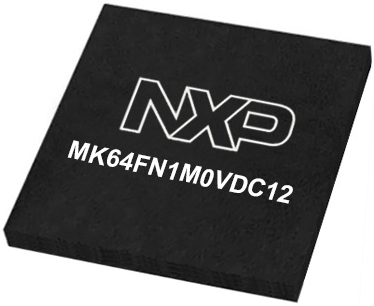
建筑
ARM Cortex-M4
MCU 内存 (KB)
1024
硅供应商
NXP
引脚数
121
RAM (字节)
262144
使用的MCU引脚
mikroBUS™映射器
“仔细看看!”
Click board™ 原理图

一步一步来
项目组装
软件支持
库描述
该库包含 8800 Retro Click 驱动程序的 API。
关键功能:
c8800retro_display_char- 此函数显示预定义字符集(IBM BIOS 8x8字体数组)中的单个字符c8800retro_get_keypad- 此函数读取KEYA和KEYB寄存器,并将寄存器的反转值存储到键盘变量中c8800retro_display_string- 此函数在LED上滚动所需的字符串
开源
代码示例
完整的应用程序代码和一个现成的项目可以通过NECTO Studio包管理器直接安装到NECTO Studio。 应用程序代码也可以在MIKROE的GitHub账户中找到。
/*!
* @file main.c
* @brief 8800Retro Click example
*
* # Description
* This example demonstrates the use of 8800 Retro Click board.
*
* The demo application is composed of two sections :
*
* ## Application Init
* Initializes the driver and issues the Click default configuration,
* then asks the user to select the demo example using the on-board KeyPad.
*
* ## Application Task
* There are 4 different demo examples: KeyPad 4x4, Full charset, Text, and Image.
* This function will run the previously selected demo example in the loop.
* The user can always switch the example by pressing the button D4 three times in a row.
* In order to run the demo examples successfully, please follow the instructions logged
* on the USB UART.
*
* @author Stefan Filipovic
*
*/
#include "board.h"
#include "log.h"
#include "c8800retro.h"
/**
* @brief 8800 Retro Click demo example values.
* @details Enum values for demo examples selection.
*/
typedef enum
{
DEMO_KEYPAD4x4,
DEMO_FULL_CHARSET,
DEMO_TEXT,
DEMO_IMAGE,
} c8800retro_demo_example_t;
static c8800retro_t c8800retro;
static log_t logger;
static c8800retro_demo_example_t demo_example = DEMO_KEYPAD4x4;
uint8_t c8800retro_demo_string[ 9 ] = { ' ', 'M', 'i', 'k', 'r', 'o', 'E', ' ', 0 };
uint8_t c8800retro_demo_logo_mikroe[ 8 ] = { 0x7F, 0xFF, 0xC0, 0xFF, 0xFF, 0xC0, 0xFF, 0x7F };
/**
* @brief 8800 Retro select demo example function.
* @details This function asks the user to select the demo example via desired buttons.
* @param[in] ctx : Click context object.
* See #c8800retro_t object definition for detailed explanation.
* @return @li @c 0 - Success,
* @li @c -1 - Error.
*
* See #err_t definition for detailed explanation.
* @note Follow the procedure written on the USB UART to select the desired demo example.
*/
static err_t c8800retro_select_demo_example( c8800retro_t *ctx );
/**
* @brief 8800 Retro demo KeyPad 4x4 example function.
* @details This function executes the KeyPad 4x4 demo example.
* @param[in] ctx : Click context object.
* See #c8800retro_t object definition for detailed explanation.
* @return @li @c 0 - Success,
* @li @c -1 - Error.
*
* See #err_t definition for detailed explanation.
* @note Follow the procedure written on the USB UART to jump out the function.
*/
static err_t c8800retro_demo_keypad4x4( c8800retro_t *ctx );
/**
* @brief 8800 Retro demo Full charset example function.
* @details This function executes the Full charset demo example.
* @param[in] ctx : Click context object.
* See #c8800retro_t object definition for detailed explanation.
* @return @li @c 0 - Success,
* @li @c -1 - Error.
*
* See #err_t definition for detailed explanation.
* @note Follow the procedure written on the USB UART to jump out the function.
*/
static err_t c8800retro_demo_full_charset( c8800retro_t *ctx );
/**
* @brief 8800 Retro demo text example function.
* @details This function executes the Text demo example.
* @param[in] ctx : Click context object.
* See #c8800retro_t object definition for detailed explanation.
* @param[in] scroll_mode : @li @c 0 - Horizontal left.
* @li @c 1 - Horizontal right.
* @li @c 2 - Vertical up.
* @li @c 3 - Vertical down.
* @param[in] scroll_speed_ms : Scroll speed in miliseconds.
* @param[in] text : Text string (up to 32 characters).
* @return @li @c 0 - Success,
* @li @c -1 - Error.
*
* See #err_t definition for detailed explanation.
* @note Follow the procedure written on the USB UART to jump out the function.
*/
static err_t c8800retro_demo_text( c8800retro_t *ctx, uint8_t scroll_mode, uint16_t scroll_speed_ms, uint8_t *text );
/**
* @brief 8800 Retro demo image example function.
* @details This function executes the Image demo example.
* @param[in] ctx : Click context object.
* See #c8800retro_t object definition for detailed explanation.
* @param[in] p_image : Pointer to image buffer (array of 8 bytes).
* @return @li @c 0 - Success,
* @li @c -1 - Error.
*
* See #err_t definition for detailed explanation.
* @note Follow the procedure written on the USB UART to jump out the function.
*/
static err_t c8800retro_demo_image( c8800retro_t *ctx, uint8_t *p_image );
void application_init ( void )
{
log_cfg_t log_cfg; /**< Logger config object. */
c8800retro_cfg_t c8800retro_cfg; /**< Click config object. */
/**
* Logger initialization.
* Default baud rate: 115200
* Default log level: LOG_LEVEL_DEBUG
* @note If USB_UART_RX and USB_UART_TX
* are defined as HAL_PIN_NC, you will
* need to define them manually for log to work.
* See @b LOG_MAP_USB_UART macro definition for detailed explanation.
*/
LOG_MAP_USB_UART( log_cfg );
log_init( &logger, &log_cfg );
log_info( &logger, " Application Init " );
// Click initialization.
c8800retro_cfg_setup( &c8800retro_cfg );
C8800RETRO_MAP_MIKROBUS( c8800retro_cfg, MIKROBUS_1 );
err_t init_flag = c8800retro_init( &c8800retro, &c8800retro_cfg );
if ( I2C_MASTER_ERROR == init_flag )
{
log_error( &logger, " Application Init Error. " );
log_info( &logger, " Please, run program again... " );
for ( ; ; );
}
c8800retro_default_cfg( &c8800retro );
c8800retro_select_demo_example( &c8800retro );
}
void application_task ( void )
{
switch ( demo_example )
{
case DEMO_KEYPAD4x4:
{
c8800retro_demo_keypad4x4 ( &c8800retro );
break;
}
case DEMO_FULL_CHARSET:
{
c8800retro_demo_full_charset ( &c8800retro );
break;
}
case DEMO_TEXT:
{
c8800retro_demo_text ( &c8800retro, C8800RETRO_SCROLL_HORIZONTAL_LEFT,
C8800RETRO_SCROLL_SPEED_MEDIUM,
c8800retro_demo_string );
break;
}
case DEMO_IMAGE:
{
c8800retro_demo_image ( &c8800retro, c8800retro_demo_logo_mikroe );
break;
}
default:
{
break;
}
}
}
int main ( void )
{
/* Do not remove this line or clock might not be set correctly. */
#ifdef PREINIT_SUPPORTED
preinit();
#endif
application_init( );
for ( ; ; )
{
application_task( );
}
return 0;
}
static err_t c8800retro_select_demo_example( c8800retro_t *ctx )
{
err_t error_flag = c8800retro_clear_display( ctx );
error_flag |= c8800retro_clear_interrupt( ctx );
for ( ; ; )
{
uint16_t keypad = C8800RETRO_KEY_NONE;
log_printf( &logger, "\r\n Press one of the following buttons to select the demo example: \r\n" );
log_printf( &logger, " A1: KeyPad 4x4 \r\n" );
log_printf( &logger, " A2: Full charset \r\n" );
log_printf( &logger, " A3: Text \r\n" );
log_printf( &logger, " A4: Image \r\n" );
// Pressed button
while( c8800retro_get_int_pin( ctx ) );
error_flag |= c8800retro_get_keypad( ctx, &keypad );
while( !c8800retro_get_int_pin( ctx ) );
// Released button
while( c8800retro_get_int_pin( ctx ) );
error_flag |= c8800retro_clear_interrupt( ctx );
while( !c8800retro_get_int_pin( ctx ) );
switch ( keypad )
{
case C8800RETRO_KEY_A1:
{
demo_example = DEMO_KEYPAD4x4;
return error_flag;
}
case C8800RETRO_KEY_A2:
{
demo_example = DEMO_FULL_CHARSET;
return error_flag;
}
case C8800RETRO_KEY_A3:
{
demo_example = DEMO_TEXT;
return error_flag;
}
case C8800RETRO_KEY_A4:
{
demo_example = DEMO_IMAGE;
return error_flag;
}
default:
{
log_printf( &logger, " Wrong button! \r\n" );
break;
}
}
}
}
static err_t c8800retro_demo_keypad4x4( c8800retro_t *ctx )
{
log_printf( &logger, "\r\n ---- KeyPad 4x4 demo example ---- \r\n" );
log_printf( &logger, " Keypad layout: \r\n" );
log_printf( &logger, " 1 2 3 A \r\n" );
log_printf( &logger, " 4 5 6 B \r\n" );
log_printf( &logger, " 7 8 9 C \r\n" );
log_printf( &logger, " * 0 # D \r\n" );
log_printf( &logger, " Press the button D4 three times to switch the example \r\n " );
uint8_t d4_cnt = 0;
err_t error_flag = c8800retro_clear_display( ctx );
error_flag |= c8800retro_clear_interrupt( ctx );
for ( ; ; )
{
uint16_t keypad = C8800RETRO_KEY_NONE;
// Pressed button
while( c8800retro_get_int_pin( ctx ) );
error_flag |= c8800retro_get_keypad( ctx, &keypad );
while( !c8800retro_get_int_pin( ctx ) );
// Released button
while( c8800retro_get_int_pin( ctx ) );
error_flag |= c8800retro_clear_interrupt( ctx );
while( !c8800retro_get_int_pin( ctx ) );
if ( keypad & C8800RETRO_KEY_D4 )
{
d4_cnt++;
}
else
{
d4_cnt = 0;
}
switch ( keypad )
{
case C8800RETRO_KEY_A1:
{
error_flag |= c8800retro_display_char( ctx, '1' );
log_printf( &logger, "1" );
break;
}
case C8800RETRO_KEY_A2:
{
error_flag |= c8800retro_display_char( ctx, '2' );
log_printf( &logger, "2" );
break;
}
case C8800RETRO_KEY_A3:
{
error_flag |= c8800retro_display_char( ctx, '3' );
log_printf( &logger, "3" );
break;
}
case C8800RETRO_KEY_A4:
{
error_flag |= c8800retro_display_char( ctx, 'A' );
log_printf( &logger, "A" );
break;
}
case C8800RETRO_KEY_B1:
{
error_flag |= c8800retro_display_char( ctx, '4' );
log_printf( &logger, "4" );
break;
}
case C8800RETRO_KEY_B2:
{
error_flag |= c8800retro_display_char( ctx, '5' );
log_printf( &logger, "5" );
break;
}
case C8800RETRO_KEY_B3:
{
error_flag |= c8800retro_display_char( ctx, '6' );
log_printf( &logger, "6" );
break;
}
case C8800RETRO_KEY_B4:
{
error_flag |= c8800retro_display_char( ctx, 'B' );
log_printf( &logger, "B" );
break;
}
case C8800RETRO_KEY_C1:
{
error_flag |= c8800retro_display_char( ctx, '7' );
log_printf( &logger, "7" );
break;
}
case C8800RETRO_KEY_C2:
{
error_flag |= c8800retro_display_char( ctx, '8' );
log_printf( &logger, "8" );
break;
}
case C8800RETRO_KEY_C3:
{
error_flag |= c8800retro_display_char( ctx, '9' );
log_printf( &logger, "9" );
break;
}
case C8800RETRO_KEY_C4:
{
error_flag |= c8800retro_display_char( ctx, 'C' );
log_printf( &logger, "C" );
break;
}
case C8800RETRO_KEY_D1:
{
error_flag |= c8800retro_display_char( ctx, '*' );
log_printf( &logger, "*" );
break;
}
case C8800RETRO_KEY_D2:
{
error_flag |= c8800retro_display_char( ctx, '0' );
log_printf( &logger, "0" );
break;
}
case C8800RETRO_KEY_D3:
{
error_flag |= c8800retro_display_char( ctx, '#' );
log_printf( &logger, "#" );
break;
}
case C8800RETRO_KEY_D4:
{
error_flag |= c8800retro_display_char( ctx, 'D' );
log_printf( &logger, "D" );
break;
}
default:
{
break;
}
}
if ( d4_cnt == 3 )
{
error_flag |= c8800retro_select_demo_example( ctx );
return error_flag;
}
}
return error_flag;
}
static err_t c8800retro_demo_full_charset( c8800retro_t *ctx )
{
log_printf( &logger, "\r\n ---- Full charset demo example ---- \r\n" );
log_printf( &logger, " Press the button D4 three times to switch the example \r\n" );
err_t error_flag = c8800retro_clear_display( ctx );
error_flag |= c8800retro_clear_interrupt( ctx );
for ( ; ; )
{
for ( uint8_t cnt = 0; cnt <= 255; cnt++ )
{
if ( cnt == 128 )
{
cnt = 160;
}
error_flag |= c8800retro_display_char( ctx, cnt );
Delay_ms ( 200 );
if ( !c8800retro_get_int_pin( ctx ) )
{
uint16_t keypad = C8800RETRO_KEY_NONE;
uint8_t d4_cnt = 0;
while ( d4_cnt < 3 )
{
// Pressed button
while( c8800retro_get_int_pin( ctx ) );
error_flag |= c8800retro_get_keypad( ctx, &keypad );
while( !c8800retro_get_int_pin( ctx ) );
// Released button
while( c8800retro_get_int_pin( ctx ) );
error_flag |= c8800retro_clear_interrupt( ctx );
while( !c8800retro_get_int_pin( ctx ) );
if ( ( keypad & C8800RETRO_KEY_D4 ) != C8800RETRO_KEY_D4 )
{
break;
}
d4_cnt++;
}
if ( d4_cnt == 3 )
{
error_flag |= c8800retro_select_demo_example( ctx );
return error_flag;
}
}
if ( C8800RETRO_ERROR == error_flag )
{
log_printf( &logger, "\r\n Error occured. \r\n" );
return error_flag;
}
}
}
}
static err_t c8800retro_demo_text( c8800retro_t *ctx, uint8_t scroll_mode, uint16_t scroll_speed_ms, uint8_t *text )
{
log_printf( &logger, "\r\n ---- Text demo example ---- \r\n" );
log_printf( &logger, " Once it finish scrolling, press the button D4 three times in the next" );
log_printf( &logger, " 3 seconds to switch the example \r\n" );
err_t error_flag = c8800retro_clear_display( ctx );
error_flag |= c8800retro_clear_interrupt( ctx );
for ( ; ; )
{
uint16_t timeout = 3000;
log_printf( &logger, "\r\n Text scrolling has started. \r\n" );
error_flag |= c8800retro_display_string( ctx, scroll_mode, scroll_speed_ms, text );
error_flag |= c8800retro_clear_interrupt( ctx );
log_printf( &logger, "\r\n Text scrolling has finished. Press the button D4 three times in the next" );
log_printf( &logger, " 3 seconds to switch the example. Otherwise, scrolling will start over. \r\n" );
while ( timeout-- > 0 )
{
if ( !c8800retro_get_int_pin( ctx ) )
{
uint16_t keypad = C8800RETRO_KEY_NONE;
uint8_t d4_cnt = 0;
while ( d4_cnt < 3 )
{
// Pressed button
while( c8800retro_get_int_pin( ctx ) );
error_flag |= c8800retro_get_keypad( ctx, &keypad );
while( !c8800retro_get_int_pin( ctx ) );
// Released button
while( c8800retro_get_int_pin( ctx ) );
error_flag |= c8800retro_clear_interrupt( ctx );
while( !c8800retro_get_int_pin( ctx ) );
if ( ( keypad & C8800RETRO_KEY_D4 ) != C8800RETRO_KEY_D4 )
{
break;
}
d4_cnt++;
}
if ( d4_cnt == 3 )
{
error_flag |= c8800retro_select_demo_example( ctx );
return error_flag;
}
}
Delay_ms ( 1 );
}
if ( C8800RETRO_ERROR == error_flag )
{
log_printf( &logger, "\r\n Error occured. \r\n" );
return error_flag;
}
}
}
static err_t c8800retro_demo_image( c8800retro_t *ctx, uint8_t *p_image )
{
log_printf( &logger, "\r\n ---- Image demo example ---- \r\n" );
log_printf( &logger, " Press the button D4 three times to switch the example \r\n" );
err_t error_flag = c8800retro_clear_display( ctx );
error_flag |= c8800retro_clear_interrupt( ctx );
error_flag |= c8800retro_display_image( ctx, p_image );
for ( ; ; )
{
if ( !c8800retro_get_int_pin( ctx ) )
{
uint16_t keypad = C8800RETRO_KEY_NONE;
uint8_t d4_cnt = 0;
while ( d4_cnt < 3 )
{
// Pressed button
while( c8800retro_get_int_pin( ctx ) );
error_flag |= c8800retro_get_keypad( ctx, &keypad );
while( !c8800retro_get_int_pin( ctx ) );
// Released button
while( c8800retro_get_int_pin( ctx ) );
error_flag |= c8800retro_clear_interrupt( ctx );
while( !c8800retro_get_int_pin( ctx ) );
if ( ( keypad & C8800RETRO_KEY_D4 ) != C8800RETRO_KEY_D4 )
{
break;
}
d4_cnt++;
}
if ( d4_cnt == 3 )
{
error_flag |= c8800retro_select_demo_example( ctx );
return error_flag;
}
}
if ( C8800RETRO_ERROR == error_flag )
{
log_printf( &logger, "\r\n Error occured. \r\n" );
return error_flag;
}
}
}
// ------------------------------------------------------------------------ END
